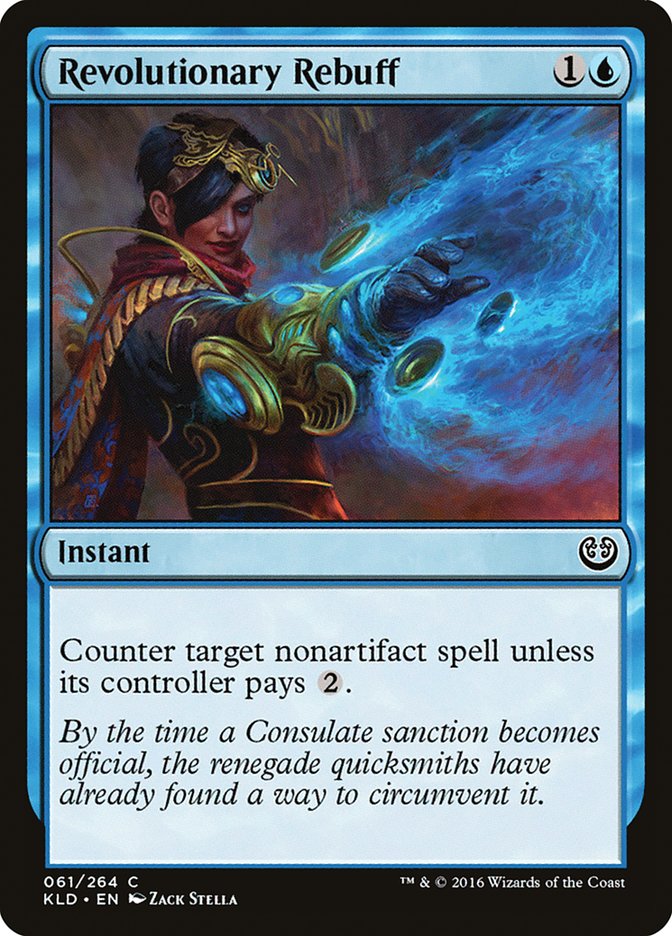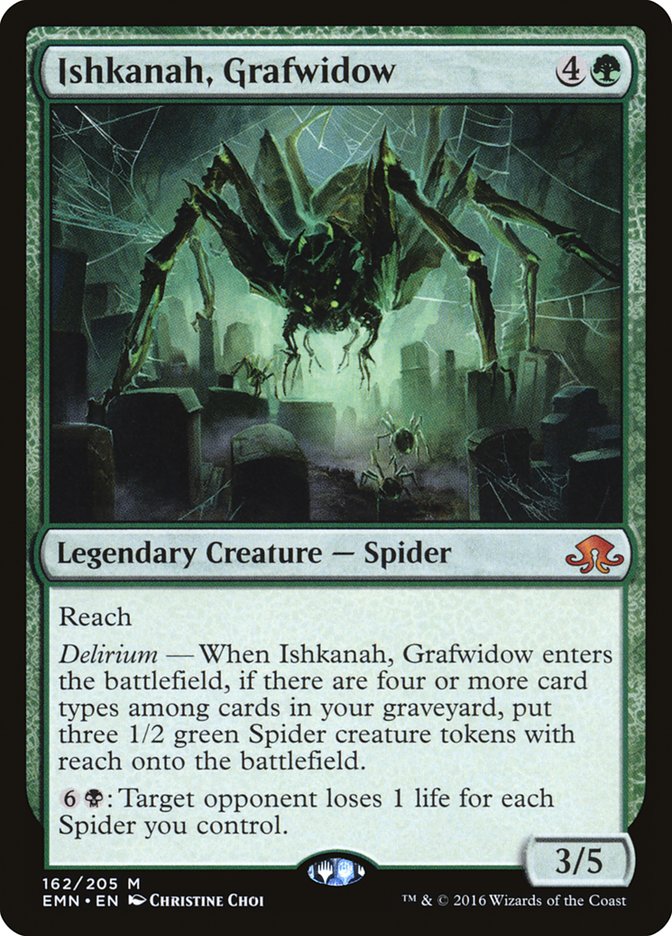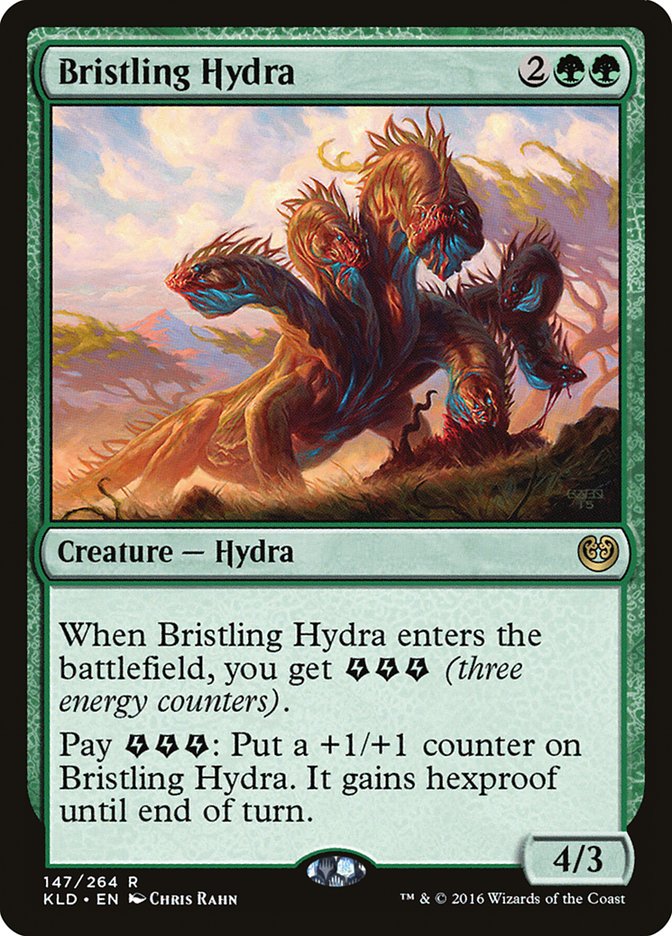Is Standard simply cyclical? Does the dominance of W/U Flash in the #SCGCOL Classic elimination rounds indicate the same could be expected for #SCGKNOX?
Granted, I don’t have a wealth of experience in the specific matchup, but for a number of weeks it seemed that conventional wisdom was that “B/G Delirum is favored against W/U Flash” or even “B/G Delirium is clearly the best deck.”
While it certainly deserves its spot on the short list of best decks to play at any given Standard tournament, what is the actual truth?
Take a look at the top-performing B/G Delirium deck from last week:
Creatures (16)
- 2 Pilgrim's Eye
- 1 Kalitas, Traitor of Ghet
- 2 Mindwrack Demon
- 2 Tireless Tracker
- 1 Emrakul, the Promised End
- 3 Ishkanah, Grafwidow
- 4 Grim Flayer
- 1 Noxious Gearhulk
Planeswalkers (4)
Lands (23)
Spells (17)

Bryan’s deck and many like his are not entirely different from Team FtF’s initial crack at B/G Delirium two Pro Tours ago. Finding a generally powerful B/G shell was simply easy moving into Kaladesh. The deck still needed the bare minimum number of enablers, removal, and means to find and recur Ishkanah, Grafwidow while utilizing Emrakul, the Promised End as a finisher.
Now contrast that with the latest builds of W/U Flash:
Spells (11)

Jack’s list is normalized and incredibly tight and tuned. It simply plays all the best four-ofs available to the strategy and then incorporates additional interaction. I also don’t want to downplay the latter point because it is so important to the rest of this piece. Despite the fact that Revolutionary Rebuff has changed from a three-of to a two-of in this list, I believe it to be the number one factor in this shift towards W/U Flash performing better on average in Standard tournaments, at least in terms of cracking the elimination rounds and often winning the tournament.
What’s the Deal with Revolutionary Rebuff?
Revolutionary Rebuff is the most-improved card in Standard as a result of metagame shifts.
When the worse Mana Leak was spoiled, I was fairly shocked. Of course, this feeling quickly faded as we all realized the initial impact of cards like Verdurous Gearhulk, and then the Pro Tour happened and Aetherworks Marvel proved to be the most popular strategy in the tournament.
That being said, as the format shifted towards the success of W/U Flash and means to answer it, notably Ishkanah, Grafwidow, the number of decks focused on artifacts has sharply declined under the guise that the raw counter magic and disruption of these two top strategies is too difficult to match.
Standard now, particularly for W/U Flash, is all about creating a small advantage and leveraging that the entire way through the game. Your cards do not become progressively better throughout the game, as B/G Delirium is able to amass mana, raw cards, and generate seven functional proxies in their deck for Emrakul, the Promised End.
In fact, no deck has a better end-game than B/G Delirium, but no other deck is so hellbent on resolving a five-mana creature to stabilize the battlefield. While there are some rare instances where a quick Grim Flayer can enable the B/G Delirium deck to be the aggressor, the vast majority of play patterns funnel the deck into stabilizing with Spiders before taking over the game in a big way.
Frankly, if Ishkanah gets Rebuffed on turn 5 or 6, B/G Delirium is going to lose that game the majority of the time if faced with meaningful pressure simultaneously. It cannot be understated how devastating trading five mana for two is in the realm of efficiency when being attacked by Gideon, Ally of Zendikar.
My biggest point here is not to simply credit those who have properly tuned W/U Flash into a great deck, but to encourage the world to branch out and start redesigning their decks. If we already know one of the answers to their problems is Revolutionary Rebuff, why don’t we start working with it?
One thing to keep in mind, however, is that Revolutionary Rebuff is a card with a limited window of effectiveness. If someone has ample time to properly play around it, they certainly will, and this only amplifies how critical it is that we incorporate the card in an aggressively slanted shell.
These various Four-Color Energy decks have been putting up some results but are still relatively under-the-radar in this Standard format. They also appear to me to be great candidates for incorporating Revolutionary Rebuff due to their aggressive nature and, frankly, playing a bunch of colors. I’ve seen several different builds, but this is where I started:
Creatures (24)
- 2 Tireless Tracker
- 4 Spell Queller
- 2 Verdurous Gearhulk
- 2 Longtusk Cub
- 4 Voltaic Brawler
- 4 Bristling Hydra
- 2 Whirler Virtuoso
- 4 Servant of the Conduit
Planeswalkers (3)
Lands (22)
Spells (11)

I learned quite a bit about the strength of the core of the deck and some initial mistakes I’d made in construction. That said, the first thing I should acknowledge is that I honestly have no clue if Woodland Wanderer or Bristling Hydra is the better card to play with. Wanderer hits hard and plays defense well but is, of course, more vulnerable. In the context of current Standard, it’s actually difficult to say which is superior because it is almost entirely based upon the matchup.
The Hydra is a massive threat against W/U Flash because it’s resistant to removal and Reflector Mage. Of course, there is also the inherent weakness of needing to always lead on one or multiple energy cards before the Hydra, lest it be killed by something as simple as Grasp of Darkness with its energy-generating trigger on the stack.
Regardless, I think that Bristling Hydra is another card in the camp of “criminally underplayed.” Despite the fact that I have no intentions of using a combo element with the card, it’s still just powerful and difficult for many strategies to handle. There just isn’t the density of sweepers of Standard played right now for folks to avoid registering this card.
My biggest takeaway from this list specifically is that Spell Queller doesn’t fit in the deck particularly well despite the signs pointing towards it being excellent. There are a few reasons for this. One, the deck isn’t as Flash-centric as the namesake U/W deck. With fewer options available to you at instant speed, the opportunity cost of passing with Spell Queller mana up is much higher.
There are also far fewer evasive threats that compound any sort of tempo advantage you can leverage. The chip damage of Spell Queller is lower-impact in this deck. Essentially, you are forced to pound your opponent with a big threat at some point in the game, and if you aren’t progressing your battlefield position in that direction early, then it will be difficult to properly leverage the Revolutionary Rebuffs that we are so interested in playing.
Again, without adequate pressure, it is trivial for an opponent in many situations to simply reach seven mana before assembling a Spider army.
Here was my second take, with an adjustment to play Woodland Wanderer specifically:
Creatures (24)
- 4 Woodland Wanderer
- 3 Tireless Tracker
- 2 Verdurous Gearhulk
- 4 Longtusk Cub
- 4 Voltaic Brawler
- 3 Whirler Virtuoso
- 4 Servant of the Conduit
Planeswalkers (3)
Lands (22)
Spells (11)

It’s a bit strange to play a singleton Cultivator’s Caravan in a deck like this, but I’ve been a big fan of introducing the card in odd places to good effect. The majority of the creatures in this Energy deck naturally turn the card on, and it is important for Four-Color Energy to extend onto the battlefield while simultaneously holding up mana to interact or even simply to generate additional advantage through Clues.
I do want to reintroduce something I’ve spoken about previously, which is the power level of Skysovereign, Consul Flagship against W/U Flash. As the W/U Flash deck continues to trend upwards, more decks should play the powerful Vehicle. It lines up well against virtually every card in their deck in addition to hitting all the sweet spots against their interaction. Play with it!
There happens to be another class of aggressive deck that can swing between two and four colors, depending on the circumstance:
Creatures (22)
- 4 Thraben Inspector
- 3 Depala, Pilot Exemplar
- 4 Scrapheap Scrounger
- 4 Toolcraft Exemplar
- 3 Inventor's Apprentice
- 4 Veteran Motorist
Lands (22)
Spells (16)

This deck clearly isn’t tuned, but it is comical how easy it is to put games away with a good draw from this Vehicles deck. It’s rare that you have difficulty getting ahead early on the battlefield; the question is maintaining it.
To play devil’s advocate a bit, it is true that the mana is at times unreliable when you’re legitimately pushing into all four colors for the first game, but Cultivator’s Caravan does good work towards making this deck stable while also posing as a menacing threat.
It’s also worth noting that Smuggler’s Copter plays fairly well with Revolutionary Rebuff on a strategic level. Later in the game, when Rebuff has lost much of its worth, it can be simply looted away.
This last list I haven’t played any games with, but pure R/B Aggro has impressed me in general and there have been several situations where the “stock” Lightning Axes have failed to live up to the rest of the deck.
Creatures (20)
Lands (22)
Spells (18)

Unfortunately there are some problems and mixed messages here. Even ignoring the mana, which isn’t great, there is tension between cards that give a deck additional reach and means of interaction that try to keep you ahead on the battlefield throughout the course of the game. Reach is intended to close the game out once attacking is no longer profitable, and having two types of cards approaching the game in a different manner doesn’t make a lot of sense.
Similarly, Bloodhall Priest appears to be the best way to build the deck, and maximizing its ability to deal damage upstairs with the support of Fiery Temper is important.
The takeaway here is that incorporating Revolutionary Rebuff into this specific deck for the sake of it doesn’t make a whole lot of sense. The fact of the matter is that none of the decks I’ve presented today may be better choices than B/G Delirium or W/U Flash. I hope my lesson is that when deck tuners are able to successfully solve problems in the metagame, it would be foolish not to try to explore other options utilizing those tools.






